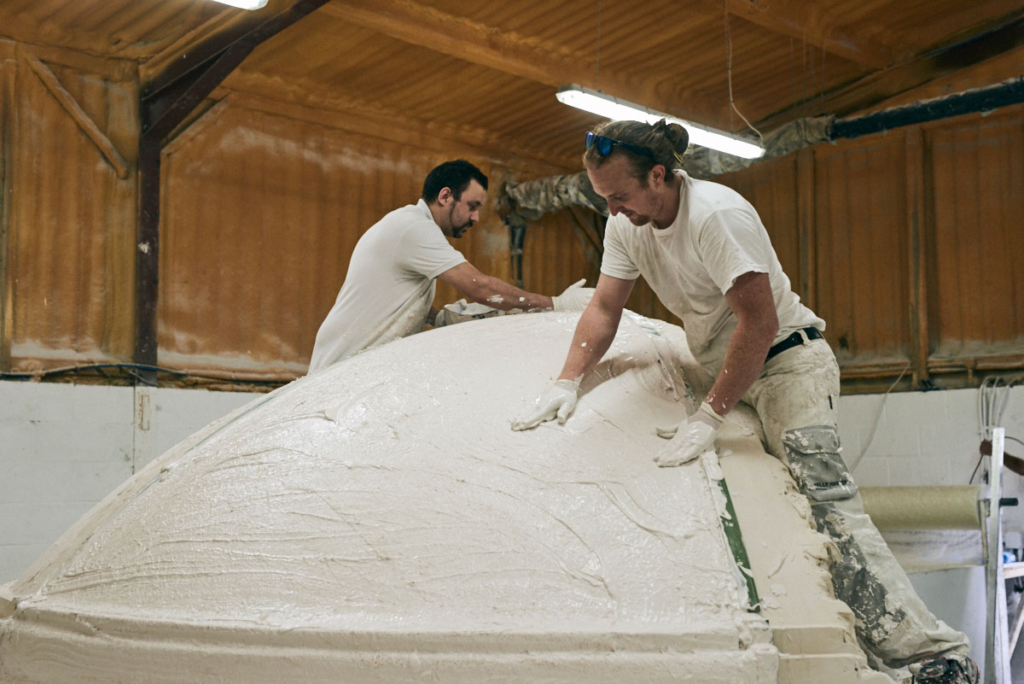Set Plasterer (1 years diploma)
Set Plasterer click here
Brief Job Description: Individuals in this job need to understand plastering
requirements, plaster a variety of surfaces and produce plaster components.
Personal Attributes: This job requires the individual to apply plaster on different
surfaces of the set as per the script requirements. The individual should possess
plastering skills e.g. how to mix components, apply plaster and achieve a smooth
finish. The individual may also have specialized plastering skills e.g. techniques to

produce specific plaster components (e.g. corners, skirtings, panels, arches, beams,
customized designs, patterns or motifs). The individual should possess basic literacy
and numeracy skills, and be able to communicate effectively with the set construction
team. The individual must be flexible and innovative, and should be able to contribute
in identifying ways to make set construction more cost effective.
Qualifications Pack For Set Plasterer
Keywords /Terms
Description
Blueprint A technical drawing of an architecture or engineering design, typically with
measurements and angles of each component
Budget Budget is an estimate of the total cost of production that may include a
break-up of cost components
Construction Schedule A detailed breakdown of activities for a construction project, with the
duration of each activity and organized in sequential order
Continuity Continuity represents the seemless transition from one shot to another
Copyright Laws A legal framework linked to intellectual property and the rights given to
creators of original products/ concepts
Draftsman (1) A visual artist who specialises in artistic drawings. Or, (2) A person who
prepares technical drawings and plans under the direction of an architect
or engineer or designer.
Dress Set Decorating the set for aesthetic/ visual purposes
Labour Laws Legal norms governing the relationship between workers, employers,
trade unions and the government
Moulds (Plastering) Cast or hollow casing into which plaster is poured and hardened to create
a specified shape. These may be single-use or re-usable
Post-production Post-production is the final finishing phase of the production, where the
raw footage is edited, special effects are added, music and sound are
integrated, colour correction is done etc.
Plaster of Paris A type of plaster formed by heating gypsum
Props A property, commonly shortened to prop (plural: props), is an object used
on stage or on screen by actors during a performance or screen
production. In practical terms, a prop is considered to be anything movable
or portable on a stage or a set.
Scale Drawings A drawing that depicts the accurate dimensions of an object, except they
have all been reduced or enlarged by a certain fixed percentage (called the
scale).
Screenplay Screenplay is the script coupled with key characteristics of the scene and
directions for acting
Script Script is a structured narrative of a story
Set The background/ scenery visible through the camera (for video
production) or directly to the spectator (for theatrical production)
Set Etiquette A set of guidelines that dictate how cast and crew should behave on set
and interact with each other
Qualifications Pack For Set Plasterer
Strike Set Process of dismantling the set (including moveable items and semipermanent fixtures), and storing, discarding or returning these items
Timelines Timelines is a listing of dates by which the production milestones/stages
need to be completed
Sector Sector is a conglomeration of different business operations having similar
businesses and interests. It may also be defined as a distinct subset of the
economy whose components share similar characteristics and interests.
Sub-sector Sub-sector is derived from a further breakdown based on the
characteristics and interests of its components.
Vertical Vertical may exist within a sub-sector representing different domain areas
or the client industries served by the industry.
Occupation Occupation is a set of job roles, which perform similar/related set of
functions in an industry

Function Function is an activity necessary for achieving the key purpose of the
sector, occupation, or area of work, which can be carried out by a person
or a group of persons. Functions are identified through functional analysis
and form the basis of OS.
Sub-functions Sub-functions are sub-activities essential to fulfill the achieving the
objectives of the function.
Job role Job role defines a unique set of functions that together form a unique
employment opportunity in an organization.
Occupational Standards
(OS)
OS specify the standards of performance an individual must achieve when
carrying out a function in the workplace, together with the knowledge and
understanding they need to meet that standard consistently. Occupational
Standards are applicable both in the Indian and global contexts.
Performance Criteria Performance Criteria are statements that together specify the standard of
performance required when carrying out a task
National Occupational
Standards (NOS)
NOS are Occupational Standards which apply uniquely in the Indian
context.
Qualifications Pack
Code
Qualifications Pack Code is a unique reference code that identifies a
qualifications pack.
Qualifications Pack(QP) Qualifications Pack comprises the set of OS, together with the educational,
training and other criteria required to perform a job role. A Qualifications
Pack is assigned a unique qualification pack code.
Unit Code Unit Code is a unique identifier for an Occupational Standard , which
isdenoted by an
Unit Title Unit Title gives a clear overall statement about what the incumbent should
be able to do.
Description Description gives a short summary of the unit content. This would be
helpful to anyone searching on a database to verify that this is the
appropriate OS they are looking for.
Scope Scope is the set of statements specifying the range of variables that an
individual may have to deal with in carrying out the function which have a
critical impact on the quality of performance required.
Knowledge and
Understanding
Knowledge and Understanding are statements which together specify the
technical, generic, professional and organizational specific knowledge that
an individual needs in order to perform to the required standard.
Organizational Context Organizational Context includes the way the organization is structured and
how it operates, including the extent of operative knowledge managers
have of their relevant areas of responsibility.
Technical Knowledge Technical Knowledge is the specific knowledge needed to accomplish
specific designated responsibilities.
Core Skills/Generic
Skills
Core Skills or Generic Skills are a group of skills that are key to learning and
working in today’s world. These skills are typically needed in any work
environment. In the context of the OS , these include communication
related skills that are applicable to most job roles

Keywords /Terms Description
POP Plaster of Paris
NOS National Occupational Standard(s)
QP Qualifications Pack
NVEQF National Vocational Education Qualifications Framework
NVQF National Vocational Qualifications Framework
Prepare surface for plastering
Description This OS unit is about preparing backgrounds and surfaces before the application of
plaster
Scope This unit/task covers the following:
Understanding the type of plaster to be applied
Estimating materials and tools
Treating surfaces before plaster is applied
Performance Criteria (PC) w.r.t. the Scope
Element Performance Criteria
Understanding the
type of plaster to be
applied
To be competent, the user/individual on the job must be able to:
PC1. correctly understand the brief provided by the production designer/ art
director and the desired end objective (eg: type of plastered surface, moulds
or effects required etc)
Estimating materials
and tools
PC2. correctly estimate the material/ tool requirements and minimize wastage,
which may include: cement, lime, plaster of paris, solvents, thinning agents and
other materials, hand and machine tools, access and working platforms (e.g.
ladders, stools, custom-built platforms etc.)
PC3. identify plastering techniqes appropriate for the task
Treating surfaces
before plaster is
applied
PC4. treat surfaces and prepare them for plastering, as per the brief and within the
required timeframe

Knowledge and Understanding (K)
A. Organizational
Context
(Knowledge of the
company /
organization and
its processes)
The user/individual on the job needs to know and understand:
KA1. the key elements of the set under construction and the reasons why the
identified finish/ effect is required for the surface
KA2. the expectations of the production designer and any key limitations on budget,
resources and time availability
B. Technical
Knowledge
The user/individual on the job needs to know and understand:
KB1. how to check the suitability of a surface for the required finish/ effect
KB2. what materials and tools would be best suited to achieve the desired results
and how to apply/ operate them
KB3. how to set-up and take down working platforms required to complete the job
KB4. techniques for preparing previously untreated surfaces
KB5. techniques for preparing previously treated surfaces
KB6. how to remove marks, defects, stickers and other materials that remain on the
surface
KB7. techniques for filling and leveling the prepared surface
KB8. application of primers, sealers and other finishing materials before the surface
can start to be painted with the required effects
Prepare surface for plastering
KB9. applicable health and safety guidelines, and minimizing the risk to the
individual’s own health and safety as well as those around him/ her
Skills (S)
A. Core Skills/
Generic Skills
Writing Skills
The user/ individual on the job needs to know and understand how to:
SA1. prepare material lists and rough estimates
Reading Skills
The user/individual on the job needs to know and understand how to:
SA2. read and correctly identify plaster, solvents, thinning agents and other
materials (e.g. brand, shade/ colour, composition etc.)
Oral Communication (Listening and Speaking skills)
The user/individual on the job needs to know and understand how to:
SA3. understand the requirements from the production design team
SA4. convey the estimated resource requirements (time, people, materials, budget)
and any constraints/ limitations
B. Professional Skills Decision Making
The user/individual on the job needs to know and understand how to:
SB1. make relevant decisions related to the area of work e.g. choice of materials
Plan and Organize
The user/individual on the job needs to know and understand:
SB2. plan his/her work according to the requirements and agreed timelines
SB3. manage within the agreed budget and minimize wastage
Problem Solving
The user/individual on the job needs to know and understand how to:
SB4. identify any problems with successful execution of the task
SB5. communicate these to the production design team and identify solutions
KB7. check for any defects, blotches or marks and repair them to achieve a uniform
plastered surface
KB8. applicable health and safety guidelines, and minimizing the risk to the
individual’s own health and safety as well as those around him/ her
Skills (S)
A. Core Skills/
Generic Skills
Writing Skills
The user/ individual on the job needs to know and understand how to:
SA1. prepare material lists and rough estimates
Reading Skills
The user/individual on the job needs to know and understand how to:
SA2. read and correctly identify plaster, cement, mixers and other materials (e.g.
brand, shade/ colour, composition etc.)
Oral Communication (Listening and Speaking skills)

The user/individual on the job needs to know and understand how to:
SA3. understand the requirements from the production design team
SA4. convey the estimated resource requirements (time, people, materials, budget)
and any constraints/ limitations
B. Professional Skills Decision Making
The user/individual on the job needs to know and understand how to:
SB1. make relevant decisions related to the area of work
Plan and Organize
The user/individual on the job needs to know and understand:
SB2. plan his/her work according to the requirements and agreed timelines
SB3. manage within the agreed material quantities and minimize wastage
Problem Solving
The user/individual on the job needs to know and understand how to:
SB4. identify any problems with successful execution of the task
SB5. communicate these to the production design team and identify solutions
Produce plaster components
Description This OS unit is about casting and moulding plaster components
Scope This unit/task covers the following:
Producing plaster components
Performance Criteria (PC) w.r.t. the Scope
Element Performance Criteria
Producing plaster
components
To be competent, the user/individual on the job must be able to:
PC1. correctly understand the brief provided by the production designer/ art
director and the desired finish/ effect
PC2. identify appropriate techniques to produce plaster components
PC3. produce casts, moulds and other plaster components, which may include:
corners, skirtings, panels, arches, beams, customized designs
PC4. correctly place and fix plaster components
PC5. complete the task within the required timeframe and minimize wastage of
materials
Knowledge and Understanding (K)
A. Organizational
Context
(Knowledge of the
company /
organization and
its processes)
The user/individual on the job needs to know and understand:
KA1. the key elements of the set under construction and the reasons why the
identified plaster component is required
KA2. the expectations of the production designer and any key limitations on budget,
resources and time availability
B. Technical Knowledge
The user/individual on the job needs to know and understand:
KB1. what materials and tools would be best suited to achieve the desired results
and how to apply/ operate them. (materials for plaster components could
include fibrous plaster, cement, lime, mixers, colours and solvents. tools for
plasterwork could include trowels, hawks, plasterboards, other cutting and
mixing tools and machine tools.)
KB2. how to set-up and take down working platforms required to complete the job
KB3. how to measure and mix various plaster components to achieve the desired
composition

KB4. how to cordon off the working area and surface to be plastered (using masking
tape, plastic sheets etc.) to ensure that plaster does not unintentionally reach
other surfaces
KB5. techniques for casting and moulding different types of plaster components
KB6. techniques for correctly placing and fixing plaster components, taking care of
joints and placing re-enforcements where required
KB7. check for any defects or cracks and repair them to ensure the plaster
component is complete and correctly installed
KB8. applicable health and safety guidelines, and minimizing the risk to the
individual’s own health and safety as well as those around him/ her
Writing Skills
The user/ individual on the job needs to know and understand how to:
SA1. prepare material lists and rough estimates
Reading Skills
The user/individual on the job needs to know and understand how to:
SA2. read and correctly identify plaster, cement, mixers and other materials (e.g.
brand, shade/ colour, composition etc.)
SA3. understand technical drawings and correctly identify the size and type of
plaster components, and the techniques required to produce them
Oral Communication (Listening and Speaking skills)
The user/individual on the job needs to know and understand how to:
SA4. understand the requirements from the production design team
SA5. convey the estimated resource requirements (time, people, materials, budget)
and any constraints/ limitations
B. Professional Skills Decision Making
The user/individual on the job needs to know and understand how to:
SB1. make relevant decisions related to the area of work
Plan and Organize
The user/individual on the job needs to know and understand:
SB2. plan his/her work according to the requirements and agreed timelines
SB3. manage within the agreed material quantities and minimize wastage
Problem Solving
The user/individual on the job needs to know and understand how to:
SB4. identify any problems with successful execution of the task
SB5. communicate these to the production design team and identify solutions
Maintain workplace health and safety
Description This OS unit is about contributing towards maintaining a healthy, safe and secure
working environment
Scope This unit/task covers the following:
understanding the health, safety and security risks prevalent at the workplace
knowing the people responsible for health and safety and the resources available
identifying and reporting risks
complying with procedures in the event of an emergency
Performance Criteria (PC) w.r.t. the Scope
Element Performance Criteria
Understanding the
health, safety and
security risks
prevalent in the
workplace
To be competent, the user/individual on the job must be able to:
PC1. maintain one’s posture and position to minimize fatigue and any risk of
injury
PC2. maintain first aid kit and keep oneself updated on the first aid procedures
PC3. identify and document potential risks like sitting postures while using
computer, eye fatigues and other hazards at the workplace
PC4. accurately maintain accident reports
PC5. report health and safety risks/ hazards to the concerned personnel
PC6. participate in organization’s health and safety knowledge sessions and drills
Knowing the people
responsible for
health and safety and
the resources
available

PC7. identify the people responsible for health and safety at the workplace,
including those to contact in case of an emergency
PC8. identify security signals e.g. fire alarms and places such as staircases, fire
warden stations, first aid and medical rooms
Identifying and
reporting risks
PC9. identify aspects of your workplace that could cause potential risk to own
and others health and safety
PC10. ensure own personal health and safety, and that of others at the workplace
through precautionary measures
PC11. identify and recommend opportunities for improving health, safety, and
security to the designated person
PC12. report any hazards outside the individual’s authority to the relevant person in
line with organisational procedures and warn other people who may be
affected
PC13. follow organization’s emergency procedures for accidents, fires or any
other natural calamity in case of a hazard
PC14. identify and correct risks like illness, accidents, fires or any other natural
calamity safely and within the limits of individual’s authority
Knowledge and Understanding (K)
A. Organizational
Context
(Knowledge of the
company /
organization and
its processes)
The user/individual on the job needs to know and understand:
KA1. organisation’s norms and policies relating to health and safety
KA2. government norms and policies regarding health and safety and related
emergency procedures
KA3. limits of authority while dealing with risks/ hazards
KA4. the importance of maintaining high standards of health and safety at a
workplace
B. Technical
Knowledge
The user/individual on the job needs to know and understand:
KB1. the different types of health and safety hazards in a workplace
KB2. safe working practices for own job role
KB3. evacuation procedures and other arrangements for handling risks
KB4. names and contact numbers of people responsible for health and safety in a
workplace
KB5. how to summon medical assistance and the emergency services, where
necessary
KB6. vendors’ or manufacturers’ instructions for maintaining health and safety while
using equipments, systems and/or machines
Skills (S) (Optional)
A. Core Skills/
Generic Skills
Writing Skills
The user/individual on the job needs to know and understand how to:
SA1. how to write and provide feedback regarding health and safety to the
concerned people
SA2. how to write and highlight potential risks or report a hazard to the concerned
people
Reading Skills
The user/individual on the job needs to know and understand how to:
SA3. read instructions, policies, procedures and norms relating to health and safety
Oral Communication (Listening and Speaking skills)
The user/individual on the job needs to know and understand how to:
SA4. highlight potential risks and report hazards to the designated people
SA5. listen and communicate information with all anyone concerned or affected
B. Professional Skills Decision making
The user/individual on the job needs to know and understand how to:
SB1. make decisions on a suitable course of action or plan
Plan and Organize
The user/individual on the job needs to know and understand how to:
SB2. plan and organize people and resources to deal with risks/ hazards that lie
within the scope of one’s individual authority
Problem Solving
The user/individual on the job needs to know and understand how to:
SB3. apply problem solving approaches in different situations
Critical Thinking
The user/individual on the job needs to know and understand how to:
SB4. understand hazards that fall within the scope of individual authority and report
all hazards that may supersede one’s authority
SB5. apply balanced judgements in different situations
Analytical Thinking
The user/individual on the job needs to know and understand how to:
SB6. analyze data and activities
Customer Centricity
The user/individual on the job needs to know and understand how to:
SB7. build and maintain positive and effective relationships with colleges and
customers








